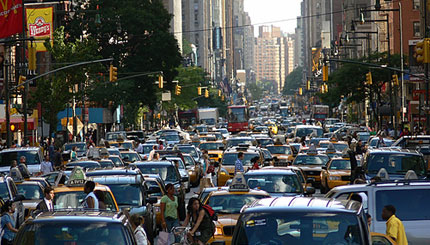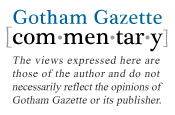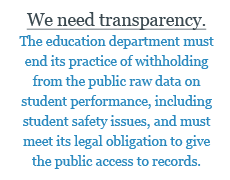Free Buses, Cheaper Subways -- and a Solution to New York's Traffic

Last spring, when Mayor Michael Bloomberg proposed an $8 "congestion fee" to drive into parts of Manhattan, the plan fell victim to several intrinsic weaknesses. Geographical inequity, for one: Manhattan residents and New Jersey drivers would have ponied up a lot less than car commuters from Brooklyn, Queens and Long Island. Lack of ambition, for another: The promised 6 percent drop in midtown gridlock seemed a meager reward for ending free use of city streets and bridges.

But the basic idea is a good one, as experience in London, Stockholm and Milan has shown. Can "congestion pricing done right," as new State Sen. Daniel Squadron has called for, fix the Bloomberg plan's flaws? With a smarter plan, can we make a serious dent in traffic tie-ups that by some estimates cost the city $13 billion a year, while creating so many winners that the plan survives the legislative gauntlet?
What This Plan Would Do
Here's one possibility:
- Replace the mayor's flat $8 toll to drive into Manhattan south of 60th Street with a sliding scale of charges. All cars and trucks trips driving across 60th Street from the north or entering midtown or lower Manhattan via a bridge or tunnel would pay a fee, but it would vary, from $10 during weekday peak hours down to $2 at night and much of the weekend. The charge would be at least twice as effective in unsnarling traffic as the mayor's $8 flat fee yet would average less -- around $6.
- Since all vehicles contribute to congestion, all vehicles pay: no "offsets" for other tolls paid by drivers from New Jersey, no matter how much they paid to cross the Hudson, and no exemptions for "black cars" driven into Manhattan to pick up or drop off their largely well-off clientele. For medallion cabs, which circulate a great deal within the "cordon" without crossing it, a surcharge on fares gives an equivalent effect.
- Dedicate the revenues from the congestion toll and taxi surcharge to eliminate bus fares (which will speed boarding), make trips within the city on Long Island Rail Road and Metro-North commuter trains free (which will help ease subway crowding), and cut subway fares.
This plan originated with Ted Kheel, the lawyer and civic activist who, for the past two years, has sponsored a research program to realize his hope of making car travel more efficient and mass transit more affordable by integrating the two systems. Kheel's foundation, Nurture New York's Nature, has funded development of a computer model -- the "Balanced Transportation Analyzer" -- that predicts how the new tolls and fare incentives will alter commuter behavior and calculates the resulting changes in travel speeds and agency revenues.
The analyzer is firmly grounded in empirical evidence. For example, to calculate how many auto commuters would shift their trip from the 6 a.m. to 9 a.m. morning peak, when the $10 toll would apply, to the 5a.m. to 6 a.m. hour, when the toll would drop to $4, the analyzer draws on data about drivers' actual time-shifting after the Port Authority instituted time-variable pricing in 2001. The same approach lets us estimate that a variable subway fare topped off at $1.50 during the 8 a.m. to 9 a.m. and 5 p.m. to 6 p.m. rush hours and tapering down before and after would cut subway ridership during those two rush hours while increasing it at less crowded times.
The analyzer is now making the rounds of the regional transportation agencies. No less an authority than "Gridlock" Sam Schwartz, the former chief traffic engineer for New York City and the dean of his profession, has pronounced the model "comprehensive, logical and the best I've seen."
Run this new congestion-pricing plan through the analyzer, and the numbers are striking. Charge a 24/7 congestion price varying from $2 to $10 and increase taxi fares by a third, and the resulting revenue could allow the Metropolitan Transportation Authority to halve the average subway fare and make all other transit inside the city, including buses and commuter trains, free. The combined carrot and stick will increase the number of people traveling into the heart of the city while reducing the number of cars. This would improve daytime traffic speeds by an average of 20 percent in Manhattan south of 60th Street and provide sizeable improvements on the approaches from the boroughs and New Jersey.
To be sure, our plan won't cure the inherited MTA deficit. Other proposals have been advanced to do that, such as the one proposed by the Ravitch Commission last fall. A "Kheel-Komanoff" plan, however, could be powerfully merged with a deficit-plugging plan, enhancing it in crucial ways. Indeed, the Ravitch plan, which may be adopted in some form this spring, is fully compatible with our model. The small -- and controversial -- portion of that plan that calls for geographically biased bridge tolls would be replaced by the Kheel-Komanoff universal toll and taxi fee. (Note to residents east of the East River: Under the Ravitch plan, which calls for bridge tolls, alone, you would account for 60 percent of all fees collected. That falls to 36 percent under Kheel-Komanoff, which spreads the burden among more drivers.)
The merged plan could keep the payroll tax Ravitch recommends as well as his calls for greater efficiency and transparency at the MTA. If additional monies are needed to fund the authority's capital budget, these could be drawn from the congestion-pricing pot by deferring some of the drop in subway fares. The provision for free buses should be inviolate, however, because many poorer New Yorkers rely on buses and they are a mainstay in communities underserved by subways.
Our plan benefits everyone, including drivers, who will pay more but get a faster and more reliable commute in return. The biggest beneficiaries may be bus riders. The free fare will not only stretch their paychecks but also speed their trips, since no one will have to stop and swipe a Metrocard to get on board. New Yorkers would see overall time savings running into billions of dollars, not to mention fewer car crashes, healthier air and an improved quality of life.
Mayor Bloomberg, Governor Paterson, MTA Chairman Sander, fellow New Yorkers: That traffic plan you've been waiting for? It's right here.
Charles Komanoff, an independent policy analyst, is president emeritus of Transportation Alternatives and a founding trustee of the Tri -State Transportation Campaign.
The Department of Education's Power Grip
While legislation giving the mayor control of the city schools had laudable goals, over the past seven years, Mayor Michael Bloomberg and Chancellor Joel Klein have demonstrated an alarmingly expansive interpretation of their own powers. Under mayoral control, government transparency has been a scarce commodity, and the Department of Education has operated like a tightly controlled bunker that excludes parents and lawmakers from most meaningful participation.
New York City's children and parents suffer the consequences of this unfettered mayoral control. Thousands of police personnel patrol city schools with little oversight or accountability. In March 2007, police personnel handcuffed and arrested 13-year-old Chelsea Fraser in front of her Dyker Heights classmates. Her crime? Writing the word "okay" on her desk. In January 2008, Denis Rivera, a 5-year-old kindergarten student was handcuffed for throwing a temper tantrum in his kindergarten class.
Principals are not immune from falling victim to the consequences of unfettered mayoral control. East Side Community High School Principal Mark Federman was arrested for pleading with police to not parade a handcuffed honor roll student in front of her classmates.
Despite these abuses, the mayor and the department refuse to create rules governing police behavior in the schools, citing mayoral control as the reason. Children and parents are left to wonder who's in charge of school discipline: the principal or the police?
Bullying based on sexuality, ethnicity and religion continues to be a major problem. According to the Department of Education's own survey, 76 percent of middle and high school students reported seeing students "threaten or bully other students at school." The City Council passed the Dignity in All Schools Act in 2004 to address this, yet the mayor has refused to fully enforce the law, claiming that the City Council has no authority over the Department of Education. Our children pay the price for this. Osama al-Najjar, a student at Tottenville High School in Staten Island, plunged into a deep depression and tried to commit suicide because he was incessantly called Osama bin Laden. Harpal Singh Vacher, a Sikh freshman at Newtown High School in Elmhurst, was attacked, wrestled to the ground and had his hair cut off by another student.
The New York Civil Liberties Union, where I am advocacy director, recently documented these failures in a report on civil rights and civil liberties under mayoral control. We drew lessons from our experiences in the schools to suggest ways to improve the school governance system and protect the safety, well-being and constitutional rights of students.
The NYCLU does not take a position on whether to renew mayoral control. We do not take a position on whether the mayor should be able to appoint a majority of Panel for Educational Policy members or whether the mayor should have sole authority to appoint the chancellor. But we hope that, in the debate over the renewal of mayoral control, state lawmakers concentrate on how our school governance system operates: Does it invite abuse of power? Does it embrace democratic principles? Is it the best system to educate, prepare and protect our youth?
Opening the System
Whether it approves extending mayoral control or not, the Legislature must ensure that our schools do not continue to operate through unchecked executive authority, excessive secrecy, and blocks to public participation and oversight. By taking steps to ensure greater transparency and accountability, the Legislature can satisfy both those who support and reject mayoral control.
First, the department cannot continue to operate as its own autonomous agency. It must be clearly defined as a city agency subject to the authority of the City Council, comptroller, public advocate, city charter and city laws, which ensure transparency and oversight.
Second, there must be an empowered board of education. Regardless of whether the mayor appoints the chancellor and a majority of members to the Panel for Educational Policy, which replaced the board, students, parents and educators would all benefit from a strong panel. The law already requires that the panel approve education policies. Now it must be strengthened to require that the chancellor submit all new citywide policies and practices that affect student achievement for the board's approval.
The authority to appoint members should be distributed among all citywide elected officials and the City Council. And in order to avoid undue influence on members and encourage thoughtful debate, panel members should serve fixed terms and elect their own chair.

Third, the parental voice in policymaking must be strengthened. The Community Education Councils and citywide councils must have responsibilities and authority that ensure parental involvement in the setting of education policies. The community and citywide councils' authority should be expanded to include approval of district school safety plans, the opening and closing of schools, and other district-specific policies.
Fourth, school safety practices must be brought in line with education policy. The police department plays a unique and expansive role in the city's schools. As the number of police personnel in the schools has increased to a whopping 5,200 agents, the ability of educators to oversee school safety and student discipline has decreased. The number of school safety agents and police officers has increased by 44 percent since 2002, making the police department's school safety division the fifth largest police force in the country. Houston, with a population of 2.2 million residents, has fewer police officers on the streets than the number of New York City police personnel patrolling New York City's million schoolchildren. Yet educators, who have experience maintaining a nurturing learning environment, have little oversight over police employees in schools. The New York state and city education departments must have clear authority to oversee all school safety practices, including police department activities.
Fifth, the public must be engaged in the decision making process. All Chancellor's Regulations -- which promulgate a wide range of policies, from admissions standards to the process for selecting parent council members -- must be subject to a public comment period. The police department does not finalize regulations without a public comment period, and neither should the Department of Education. The board or Panel on Educational Policy also must open its policymaking and adjudication process to the public, and ensure that parents are welcomed to and informed about its meetings.
Sixth, we need transparency. The education department must end its practice of withholding from the public raw data on student performance, including student safety issues, and must meet its legal obligation to give the public access to records. For example, the department has failed to provide the public with raw data on who is getting arrested in our schools, why children are leaving school without graduating, and who is getting suspended and for what. Without access to such information, the public cannot determine whether the city's educational environment is truly improving. To allow for an independent assessment of the department's data, the Independent Budget Office must have authority to report on the education department's performance, as it does on other city agencies.
Seventh, the legislature must create an Office of Inspector General to conduct independent audits and investigations into Department of Education practices. The inspector general should investigate systemic problems that affect the educational environment. For example, the inspector general should look into whether the dramatic increase in the number of police personnel in the schools has had a negative impact on the educational environment.
Finally, the legislature must allow the law to sunset again in seven years. The debate over the best school governance structure for our children has led to passionate discussions among policymakers and the public and a renewed interest in city schools. Whichever system the legislature chooses, it must expire, allowing for a continuous public debate.
The current regime of mayoral control is incompatible with a transparent and accountable educational environment. The legislature must address the lack of checks and balances and close legislative loopholes that have allowed a secretive and unaccountable Department of Education to flourish.

Udi Ofer is advocacy director of the New York Civil Liberties Union and author of the report.
The Obama Stimulus: An $825 Billion First Step

For More on Helping New York's Economy
Paying Attention to Cities By Jonathan Bowles
After years of federal policies neglecting urban areas, Barack Obama has sent some encouraging signals that he understands their importance. Certainly, New York could use a helping hand. The director of the Center for an Urban Future lays out some ideas for what the president could do to aid New York.
Using the Crisis to Prevent the Next One By J. Mijin Cha
The current turmoil can help us reduce our dependence on Wall Street and create good "green collar" jobs that help fuel a resurgence of the middle class. The director of campaign research at the Urban Agenda explains how.
Infrastructure Investments that Make Sense By Carter Craft
As big as the stimulus package may be, the country has to invest the money wisely. An urban planner offers some novel ideas for New York projects -- from recycling grease to ferries for freight.
From Gas-Guzzling Cars to Clean Buses By Charles Stone
Simply lending funds to struggling auto companies won't spur economic growth. Instead, an economist suggests, the government should create a voucher program to deploy the resources of the auto companies, spur investment -- and help the environment.
Previous Articles
A Federal Stimulus for City Parks By Anne Schwartz
Advocates hope that President Obama and Congress will recognize that funding parks would not only improve the quality of life and the environment but also spur investment and raise real estate values.
Stimulus Money: The Downturn's Silver Lining? By Graham Beck
The stimulus package could offer more federal funds for transportation projects. The MTA is making its list, but there are sure to be lots of restrictions -- and competition.
The version of the American Recovery and Reinvestment Plan unveiled on Jan. 15 by House Democrats is breathtaking in its scope and cost. Intended to retain and create 3.7 million jobs over the next two years, the $825 billion package of federal government investments includes dozens of spending measures ranging from $200 billion in fiscal relief to help state and local governments, to $6 billion to extend broadband to rural areas, a 21st century version of Depression-era rural electrification. Two thirds of the total value consists of spending, with one third for tax cuts.
Negotiated with President Barack Obama's transition team, the plan - a.k.a. Stimulus II or ARRP - is an important first step to halt the downward economic spiral triggered by last fall's financial meltdown. As large as it is, though-5 percent of gross domestic product-it is not sufficient to create a sustained recovery. Two other steps are essential. First, more dramatic action is needed to put the brakes on the collapsing housing market. Second, making a recovery sustainable will require a set of policies to lift wages and bolster the middle class. Without these two complementary steps, ARRP might provide temporary relief for our economic illness but not a cure.
Helping the States
Whatever its limitations as a long-term solution, ARRP will provide much-welcome short-term budget relief for New York and other states (45 states face budget gaps). The plan will increase the federal share of Medicaid spending and provide billions in education aid to states and school districts. Both of these measures will help to moderate the severe budget cuts proposed by Gov. David Paterson. New York State should receive upward of $10 billion - and possibly as much as $15 billion - over two years -- funds that will help close the state's budget gaps. Such federal relief will help states maintain their spending and prevent spending cuts or tax increases, both of which would have intensified the downward economic spiral.
Help for a Teetering Economy
A year ago, Congress and the Bush administration agreed to a $150 billion stimulus package that consisted largely of tax rebates. Most economists now agree that last year's stimulus was not up to the task because tax cuts provide less "economic bang for the buck" than most other forms of stimulus. Economic forecaster Mark Zandi, a former advisor to presidential candidate John McCain, estimates that every dollar in tax cuts generates only $1.01 in economic activity, much lower than the spending impact of increasing unemployment compensation ($1.63), state fiscal relief ($1.38) or spending on infrastructure ($1.59). Also, since the tax rebate checks were sent out in May and June, when gasoline prices were skyrocketing, many recipients spent the money to cover their gas costs.

The magnitude of a proposed second stimulus has mounted steadily since last September's financial market meltdown and the ensuing sharp collapse in the consumer spending that accounts for 70 percent of demand in the economy. The spending collapse was compounded by a credit market freeze as Wall Street firms and banks confronted a mountain of bad debts created by high-risk lending and unregulated gambling. The crash of the housing and stock markets destroyed literally trillions in home equity and retirement savings held by millions of middle class households. Along with steadily mounting job losses, this caused households to sharply reduce spending. The collapse of consumer spending is thought to have pulled GDP down by as much as 5 percent during the fourth quarter of 2008.
It is no exaggeration to say that this is the worst economy since the Great Depression. The 2.6 million jobs lost in 2008 were more than in any year since 1945. Overall unemployment could be 9 percent by the end of the year and 11 percent in 2010 in the absence of the recovery plan, according to economist Zandi. Already, unemployment among adult black men is 13.4 percent. Housing prices have fallen 25 percent on average. There were 2.25 million home mortgage foreclosures last year, and one out of every six homeowners owes more on their mortgage than their house is worth.
What Stimulus II Would Do
The proposed American Recovery and Reinvestment Plan is a 21st century version of a government-led recovery and investment program, combining some of the best elements of the Depression-era Works Progress Administration, the Eisenhower era commitment to build the Interstate Highway System, the Apollo Project, and the Great Society. The plan includes spending that will not only provide some short-term stimulus but will increase the long-term productive capacity or efficiency of the economy.
One of the biggest components is $52 billion for various "green jobs" programs from weatherizing public buildings (see related story) and homes to reduce energy demand, to developing a "smart" electric power grid that is both more reliable and better able to transmit clean, renewable energy.
The package would also create jobs by spending $67 billion for infrastructure. Because of the urgent need to boost jobs as quickly as possible, it emphasizes "shovel ready" projects, including mass transit systems, highways, bridges, airports, national parks, water and sewer systems, flood control, and environmental cleanup. The Metropolitan Transit Authority will be able to use some of these monies to fund some of the construction projects and equipment needs in its capital budget. Governor David Paterson submitted an extensive list of 1,922 "ready-to-go" projects to the Obama transition team.
This second stimulus package provides $12 billion to support forward-looking research and development investments that could be particularly important in the future, including biomedical, climate change and alternative energy research, and funds to modernize and expand government and university research facilities.
The ARRP includes $5 billion for job training and employment services, including $1.2 billion to create 1 million summer jobs for youth. It offers additional -- and substantial funds -- for worker training and education as part of the education, healthcare, and science and technology initiatives. There is $5 billion for early childhood development, including additional slots in subsidized childcare and Head Start.
A particularly critical part of ARRP is aid to the unemployed. The program includes $36 billion to extend and modestly increase unemployment benefits, and incentives to encourage states to expand unemployment insurance coverage for low-wage and part-time workers. An additional $30 billion would subsidize health coverage for unemployed workers and provide 100 percent federal funding (i.e., dropping the requirement for a state match) for two years for Medicaid-eligible workers who become unemployed.
Nearly $30 billion would go to increase food stamps, low-income heating assistance, assistance provided under federal Supplemental Security Income, aid for the homeless and Temporary Assistance for Needy Families block grants. A total of more than $11 billion would fund repair and modernization of public housing, help communities build and rehabilitate low-income housing using green technologies, and enable communities to purchase and rehabilitate foreclosed and vacant properties.
Stimulus II and New York
New York's unemployed workers, their families, the state government and local governments and the broader New York economy will benefit significantly from this much-needed and unprecedented economic recovery plan. New York, though, must make sure that the billions of federal dollars it will receive for infrastructure, energy development and other projects lead to the creation of good jobs that provide decent wages, benefits and career development opportunities. This plan also presents New York with a golden opportunity to develop a strategic plan to revitalize the upstate economy and help the downstate economy adjust to a permanently smaller role for the finance sector.
Stopping the Housing Collapse
The Obama team has suggested ways to use some of the remaining funds from the $700 billion Emergency Economic Stabilization Act, the so-called "bailout" that was passed in early October, to address the housing crisis. In a Jan. 15 to Congress, Larry Summers, who is to be director of the National Economic Council, indicated the new administration would commit $50 billion to $100 billion to "reduce the number of preventable foreclosures," reform bankruptcy laws, revamp the modest Hope for Homeowners program, and require banks receiving bailout assistance to "implement mortgage foreclosure mitigation" programs.
These measures can only help but may well not be sufficient to ensure that banks renegotiate mortgages on the scale necessary to halt the slide in housing prices. Until that happens, housing prices may fall further and the value of the mortgages and mortgage-backed assets that dominate the balance sheets of the major financial institutions will remain questionable. Investor's suspicions about the "toxicity" of these assets have paralyzed credit markets for most of the past year.
Originally, the $700 billion financial "bailout" was supposed to take those toxic assets off the hands of the banks, under the Trouble Asset Recovery Program or TARP. Some of the remaining $350 billion could be used for this. Now, though, the incoming Obama administration appears to be considering whether to provide another round of massive funding ($1 trillion or more) to salvage bank portfolios.
Given the magnitude and character of the federal interventions so far, the banking system already has been effectively nationalized and is "private" in name only. While the government has allowed bank executives to remain in control, at some point, Washington leaders will have to decide whether taxpayers might be better served by completing the nationalization of the banking system rather than trying to revive banks that have impaled themselves on massive amounts of toxic assets. To date, the overall magnitude of taxpayer resources pledged to financial market rescue can only be described as "galactic" -- $7 trillion to $8 trillion in capital infusions, low-interest loans and federal guarantees.
Boosting the Middle Class
Along with the dual collapse of the housing and financial markets, the middle class squeeze played a major role the current economic precariousness. Wages have not kept pace with productivity or with the health and retirement security costs employers have shifted to workers. As a result, the average working family has been forced to take on substantial home equity or credit card debt in recent years to try to maintain living standards. The absence of a firm foundation for middle class prosperity meant that economic growth from 2003 to 2007 was possible only because of the economy's bubble tendency and the excessive reliance on borrowing at every level.
Boosting the middle class through higher wages and increased economic security involves such things as passage of the Employee Free Choice Act that will remove barriers imposed by the current labor law system that frustrate workers' efforts to join unions.
The American Recovery and Reinvestment Program is an essential step for the U.S. to take in pulling the economy out of this historic slump. As the House leadership's version of ARRP is negotiated in the House and with the Senate, it is critical that the provisions aiding states and low-income populations remain the centerpiece and that any business tax cuts be limited. To achieve a balanced and long-lasting prosperity, however, other actions will be needed to resolve the housing crisis and to rebuild the middle class. Without such policies, the recovery and reinvestment plan might create a short-term rebound but one that will fizzle out after two or three years.
The new administration gives every indication that it is aware of the need for these complementary actions. Time will tell whether it can achieve initial success on the economic recovery front and build the political support to turn recovery into sustained prosperity.
James Parrott is deputy director and chief economist of the Fiscal Policy Institute. He has been studying and writing about the New York economy since he landed in New York City a quarter century ago.




